Development of a Person-centred Care Plan Assignment 2022
VerifiedAdded on 2022/09/23
|14
|3599
|24
Assignment
AI Summary
Contribute Materials
Your contribution can guide someone’s learning journey. Share your
documents today.

NURS2004
Assignment 2: Development of a Person-centred Care Plan
Man Yu Tsoi (2210192) Class No: NS1
Introduction:
The patient's name is Mr Clarke, a 72-year-old man who is presented with
respiratory distress and anxiety. The patient was admitted to the respiratory ward of
the hospital as he was suffering from an acute exacerbation of Chronic Obstructive
Pulmonary Disease (COPD). The patient showed symptoms of shortness of breath,
coughing and his body temperature 39 degrees which meant he had a fever. The
subject was diagnosed with acute exacerbation of Mr Clarke had a history of the past
medical history of hypercholesterolemia, myocardial infarction (MI) and chronic
obstructive pulmonary disease. Mr Clarke has a surgical history of coronary artery
stent insertion and appendectomy. In addition, he has allergies of Micropore tape –
blisters.
The first step is discussing what assessment information should be collected and how
would it be collected. Then, I will focus on discussing two nursing diagnoses that are
ineffective breathing pattern problems and activity intolerance problems. The third
step is planning the nursing intervention of care patients and goal outcomes based
on the diagnoses. The fourth step is to plan the implementation of the planned
interventions. Evaluation of the outcomes to check whether the intervention is
effective is the critical step (Toney-Butler, 2019). Moreover, the respiratory nurse,
nutritionist, physical therapist and other health professionals from the
multidisciplinary team (MDT) can deliver patient-centred care, showing compliance
with the bioethics. The law and ethics are an important part of the nursing
profession and it was vital to address all the aspects in the care process to offer a
Assignment 2: Development of a Person-centred Care Plan
Man Yu Tsoi (2210192) Class No: NS1
Introduction:
The patient's name is Mr Clarke, a 72-year-old man who is presented with
respiratory distress and anxiety. The patient was admitted to the respiratory ward of
the hospital as he was suffering from an acute exacerbation of Chronic Obstructive
Pulmonary Disease (COPD). The patient showed symptoms of shortness of breath,
coughing and his body temperature 39 degrees which meant he had a fever. The
subject was diagnosed with acute exacerbation of Mr Clarke had a history of the past
medical history of hypercholesterolemia, myocardial infarction (MI) and chronic
obstructive pulmonary disease. Mr Clarke has a surgical history of coronary artery
stent insertion and appendectomy. In addition, he has allergies of Micropore tape –
blisters.
The first step is discussing what assessment information should be collected and how
would it be collected. Then, I will focus on discussing two nursing diagnoses that are
ineffective breathing pattern problems and activity intolerance problems. The third
step is planning the nursing intervention of care patients and goal outcomes based
on the diagnoses. The fourth step is to plan the implementation of the planned
interventions. Evaluation of the outcomes to check whether the intervention is
effective is the critical step (Toney-Butler, 2019). Moreover, the respiratory nurse,
nutritionist, physical therapist and other health professionals from the
multidisciplinary team (MDT) can deliver patient-centred care, showing compliance
with the bioethics. The law and ethics are an important part of the nursing
profession and it was vital to address all the aspects in the care process to offer a
Secure Best Marks with AI Grader
Need help grading? Try our AI Grader for instant feedback on your assignments.

high quality of care to the patient. Moreover, the duty of care is taken into
consideration which is stated to be a moral or legal obligation that ensures patient’s
safety by adhering to the standards of care while performing the act and prevent any
harm to the patient. Thus, identification and assessment of all the vital signs and
acting according is a crucial task for the healthcare professionals in order to save the
life of a patient.
Body 1: (Ineffective breathing pattern)
1) Assessment
According to the record and nursing notes on day 0, Mr Clarke felt tired
and appeared breathless when he was sitting out. In addition, the CT
scan showed and confirmed bilateral lower lobe pneumonia. This above
information can help nurses effectively to carry out the intervention
planning process (Terry, Bowman & West, 2019). In addition, patients
who are unable to breathe properly and who cannot inhale adequately
are shown by improper lung expansion and contraction. Unequal and
strenuous breathing on the sides of the chest, rendered the abdomen
shifted, and attributed to the ineffective breathing patterns (Gil, 2019).
The ineffective breathing patterns signified dyspnea, cough, decreased
total vital capacity, decreased partial pressure of Oxygen (PO2) and
decreased oxygen saturation (SaO2) as per the case study. The partial
pressure of carbon dioxide (Pco2) was also very much raised in the
case of Mr Clake that heightened the risk of cyanosis (Gil, 2019). The
nurse must continuously evaluate the patient, using the Finger pulse
oximeter to assess and record the breathing rate regularly. The average
breathing rate for adults is 10 to 20 breaths per hour and the subject
consideration which is stated to be a moral or legal obligation that ensures patient’s
safety by adhering to the standards of care while performing the act and prevent any
harm to the patient. Thus, identification and assessment of all the vital signs and
acting according is a crucial task for the healthcare professionals in order to save the
life of a patient.
Body 1: (Ineffective breathing pattern)
1) Assessment
According to the record and nursing notes on day 0, Mr Clarke felt tired
and appeared breathless when he was sitting out. In addition, the CT
scan showed and confirmed bilateral lower lobe pneumonia. This above
information can help nurses effectively to carry out the intervention
planning process (Terry, Bowman & West, 2019). In addition, patients
who are unable to breathe properly and who cannot inhale adequately
are shown by improper lung expansion and contraction. Unequal and
strenuous breathing on the sides of the chest, rendered the abdomen
shifted, and attributed to the ineffective breathing patterns (Gil, 2019).
The ineffective breathing patterns signified dyspnea, cough, decreased
total vital capacity, decreased partial pressure of Oxygen (PO2) and
decreased oxygen saturation (SaO2) as per the case study. The partial
pressure of carbon dioxide (Pco2) was also very much raised in the
case of Mr Clake that heightened the risk of cyanosis (Gil, 2019). The
nurse must continuously evaluate the patient, using the Finger pulse
oximeter to assess and record the breathing rate regularly. The average
breathing rate for adults is 10 to 20 breaths per hour and the subject
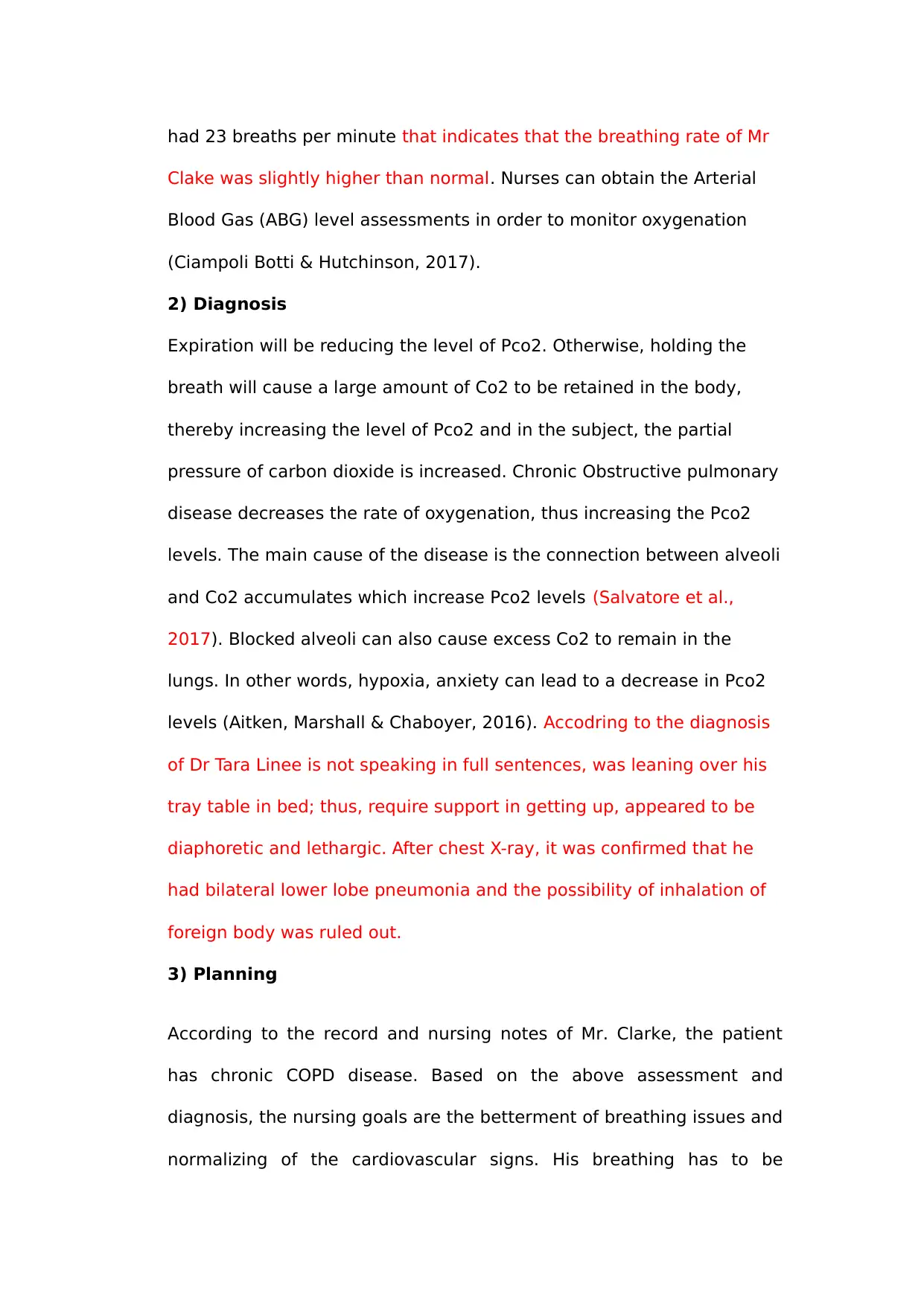
had 23 breaths per minute that indicates that the breathing rate of Mr
Clake was slightly higher than normal. Nurses can obtain the Arterial
Blood Gas (ABG) level assessments in order to monitor oxygenation
(Ciampoli Botti & Hutchinson, 2017).
2) Diagnosis
Expiration will be reducing the level of Pco2. Otherwise, holding the
breath will cause a large amount of Co2 to be retained in the body,
thereby increasing the level of Pco2 and in the subject, the partial
pressure of carbon dioxide is increased. Chronic Obstructive pulmonary
disease decreases the rate of oxygenation, thus increasing the Pco2
levels. The main cause of the disease is the connection between alveoli
and Co2 accumulates which increase Pco2 levels (Salvatore et al.,
2017). Blocked alveoli can also cause excess Co2 to remain in the
lungs. In other words, hypoxia, anxiety can lead to a decrease in Pco2
levels (Aitken, Marshall & Chaboyer, 2016). Accodring to the diagnosis
of Dr Tara Linee is not speaking in full sentences, was leaning over his
tray table in bed; thus, require support in getting up, appeared to be
diaphoretic and lethargic. After chest X-ray, it was confirmed that he
had bilateral lower lobe pneumonia and the possibility of inhalation of
foreign body was ruled out.
3) Planning
According to the record and nursing notes of Mr. Clarke, the patient
has chronic COPD disease. Based on the above assessment and
diagnosis, the nursing goals are the betterment of breathing issues and
normalizing of the cardiovascular signs. His breathing has to be
Clake was slightly higher than normal. Nurses can obtain the Arterial
Blood Gas (ABG) level assessments in order to monitor oxygenation
(Ciampoli Botti & Hutchinson, 2017).
2) Diagnosis
Expiration will be reducing the level of Pco2. Otherwise, holding the
breath will cause a large amount of Co2 to be retained in the body,
thereby increasing the level of Pco2 and in the subject, the partial
pressure of carbon dioxide is increased. Chronic Obstructive pulmonary
disease decreases the rate of oxygenation, thus increasing the Pco2
levels. The main cause of the disease is the connection between alveoli
and Co2 accumulates which increase Pco2 levels (Salvatore et al.,
2017). Blocked alveoli can also cause excess Co2 to remain in the
lungs. In other words, hypoxia, anxiety can lead to a decrease in Pco2
levels (Aitken, Marshall & Chaboyer, 2016). Accodring to the diagnosis
of Dr Tara Linee is not speaking in full sentences, was leaning over his
tray table in bed; thus, require support in getting up, appeared to be
diaphoretic and lethargic. After chest X-ray, it was confirmed that he
had bilateral lower lobe pneumonia and the possibility of inhalation of
foreign body was ruled out.
3) Planning
According to the record and nursing notes of Mr. Clarke, the patient
has chronic COPD disease. Based on the above assessment and
diagnosis, the nursing goals are the betterment of breathing issues and
normalizing of the cardiovascular signs. His breathing has to be
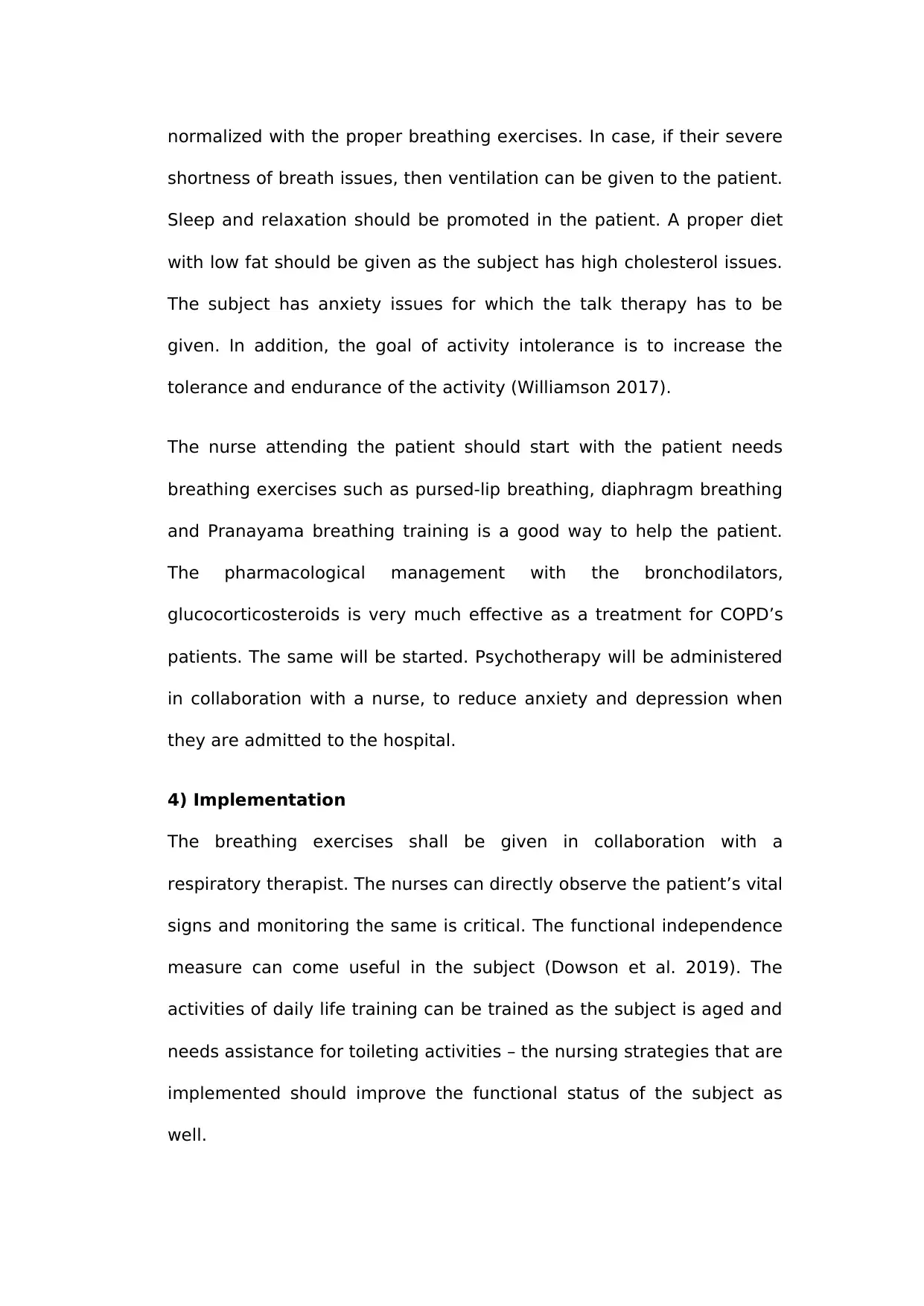
normalized with the proper breathing exercises. In case, if their severe
shortness of breath issues, then ventilation can be given to the patient.
Sleep and relaxation should be promoted in the patient. A proper diet
with low fat should be given as the subject has high cholesterol issues.
The subject has anxiety issues for which the talk therapy has to be
given. In addition, the goal of activity intolerance is to increase the
tolerance and endurance of the activity (Williamson 2017).
The nurse attending the patient should start with the patient needs
breathing exercises such as pursed-lip breathing, diaphragm breathing
and Pranayama breathing training is a good way to help the patient.
The pharmacological management with the bronchodilators,
glucocorticosteroids is very much effective as a treatment for COPD’s
patients. The same will be started. Psychotherapy will be administered
in collaboration with a nurse, to reduce anxiety and depression when
they are admitted to the hospital.
4) Implementation
The breathing exercises shall be given in collaboration with a
respiratory therapist. The nurses can directly observe the patient’s vital
signs and monitoring the same is critical. The functional independence
measure can come useful in the subject (Dowson et al. 2019). The
activities of daily life training can be trained as the subject is aged and
needs assistance for toileting activities – the nursing strategies that are
implemented should improve the functional status of the subject as
well.
shortness of breath issues, then ventilation can be given to the patient.
Sleep and relaxation should be promoted in the patient. A proper diet
with low fat should be given as the subject has high cholesterol issues.
The subject has anxiety issues for which the talk therapy has to be
given. In addition, the goal of activity intolerance is to increase the
tolerance and endurance of the activity (Williamson 2017).
The nurse attending the patient should start with the patient needs
breathing exercises such as pursed-lip breathing, diaphragm breathing
and Pranayama breathing training is a good way to help the patient.
The pharmacological management with the bronchodilators,
glucocorticosteroids is very much effective as a treatment for COPD’s
patients. The same will be started. Psychotherapy will be administered
in collaboration with a nurse, to reduce anxiety and depression when
they are admitted to the hospital.
4) Implementation
The breathing exercises shall be given in collaboration with a
respiratory therapist. The nurses can directly observe the patient’s vital
signs and monitoring the same is critical. The functional independence
measure can come useful in the subject (Dowson et al. 2019). The
activities of daily life training can be trained as the subject is aged and
needs assistance for toileting activities – the nursing strategies that are
implemented should improve the functional status of the subject as
well.
Secure Best Marks with AI Grader
Need help grading? Try our AI Grader for instant feedback on your assignments.
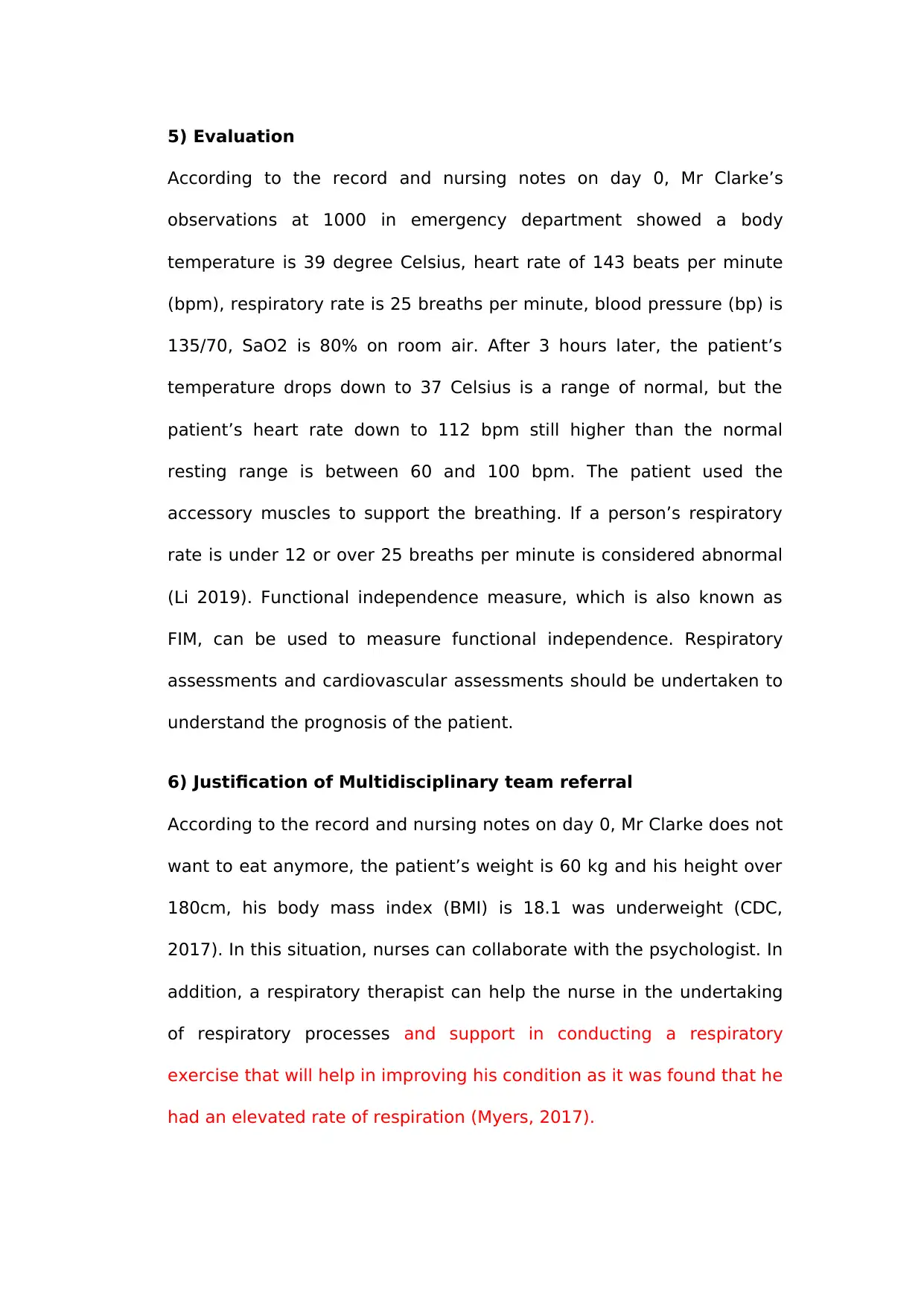
5) Evaluation
According to the record and nursing notes on day 0, Mr Clarke’s
observations at 1000 in emergency department showed a body
temperature is 39 degree Celsius, heart rate of 143 beats per minute
(bpm), respiratory rate is 25 breaths per minute, blood pressure (bp) is
135/70, SaO2 is 80% on room air. After 3 hours later, the patient’s
temperature drops down to 37 Celsius is a range of normal, but the
patient’s heart rate down to 112 bpm still higher than the normal
resting range is between 60 and 100 bpm. The patient used the
accessory muscles to support the breathing. If a person’s respiratory
rate is under 12 or over 25 breaths per minute is considered abnormal
(Li 2019). Functional independence measure, which is also known as
FIM, can be used to measure functional independence. Respiratory
assessments and cardiovascular assessments should be undertaken to
understand the prognosis of the patient.
6) Justification of Multidisciplinary team referral
According to the record and nursing notes on day 0, Mr Clarke does not
want to eat anymore, the patient’s weight is 60 kg and his height over
180cm, his body mass index (BMI) is 18.1 was underweight (CDC,
2017). In this situation, nurses can collaborate with the psychologist. In
addition, a respiratory therapist can help the nurse in the undertaking
of respiratory processes and support in conducting a respiratory
exercise that will help in improving his condition as it was found that he
had an elevated rate of respiration (Myers, 2017).
According to the record and nursing notes on day 0, Mr Clarke’s
observations at 1000 in emergency department showed a body
temperature is 39 degree Celsius, heart rate of 143 beats per minute
(bpm), respiratory rate is 25 breaths per minute, blood pressure (bp) is
135/70, SaO2 is 80% on room air. After 3 hours later, the patient’s
temperature drops down to 37 Celsius is a range of normal, but the
patient’s heart rate down to 112 bpm still higher than the normal
resting range is between 60 and 100 bpm. The patient used the
accessory muscles to support the breathing. If a person’s respiratory
rate is under 12 or over 25 breaths per minute is considered abnormal
(Li 2019). Functional independence measure, which is also known as
FIM, can be used to measure functional independence. Respiratory
assessments and cardiovascular assessments should be undertaken to
understand the prognosis of the patient.
6) Justification of Multidisciplinary team referral
According to the record and nursing notes on day 0, Mr Clarke does not
want to eat anymore, the patient’s weight is 60 kg and his height over
180cm, his body mass index (BMI) is 18.1 was underweight (CDC,
2017). In this situation, nurses can collaborate with the psychologist. In
addition, a respiratory therapist can help the nurse in the undertaking
of respiratory processes and support in conducting a respiratory
exercise that will help in improving his condition as it was found that he
had an elevated rate of respiration (Myers, 2017).
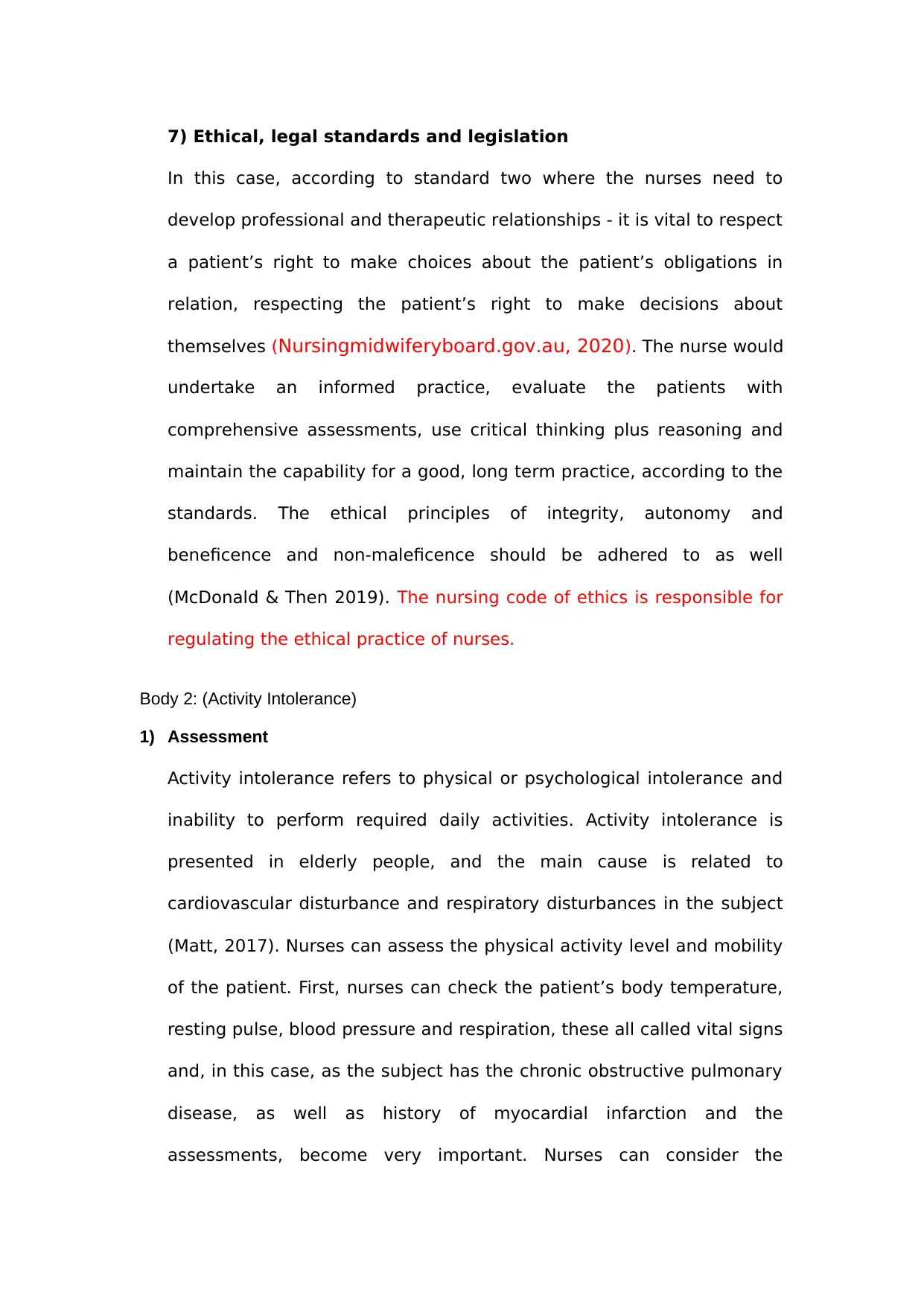
7) Ethical, legal standards and legislation
In this case, according to standard two where the nurses need to
develop professional and therapeutic relationships - it is vital to respect
a patient’s right to make choices about the patient’s obligations in
relation, respecting the patient’s right to make decisions about
themselves (Nursingmidwiferyboard.gov.au, 2020). The nurse would
undertake an informed practice, evaluate the patients with
comprehensive assessments, use critical thinking plus reasoning and
maintain the capability for a good, long term practice, according to the
standards. The ethical principles of integrity, autonomy and
beneficence and non-maleficence should be adhered to as well
(McDonald & Then 2019). The nursing code of ethics is responsible for
regulating the ethical practice of nurses.
Body 2: (Activity Intolerance)
1) Assessment
Activity intolerance refers to physical or psychological intolerance and
inability to perform required daily activities. Activity intolerance is
presented in elderly people, and the main cause is related to
cardiovascular disturbance and respiratory disturbances in the subject
(Matt, 2017). Nurses can assess the physical activity level and mobility
of the patient. First, nurses can check the patient’s body temperature,
resting pulse, blood pressure and respiration, these all called vital signs
and, in this case, as the subject has the chronic obstructive pulmonary
disease, as well as history of myocardial infarction and the
assessments, become very important. Nurses can consider the
In this case, according to standard two where the nurses need to
develop professional and therapeutic relationships - it is vital to respect
a patient’s right to make choices about the patient’s obligations in
relation, respecting the patient’s right to make decisions about
themselves (Nursingmidwiferyboard.gov.au, 2020). The nurse would
undertake an informed practice, evaluate the patients with
comprehensive assessments, use critical thinking plus reasoning and
maintain the capability for a good, long term practice, according to the
standards. The ethical principles of integrity, autonomy and
beneficence and non-maleficence should be adhered to as well
(McDonald & Then 2019). The nursing code of ethics is responsible for
regulating the ethical practice of nurses.
Body 2: (Activity Intolerance)
1) Assessment
Activity intolerance refers to physical or psychological intolerance and
inability to perform required daily activities. Activity intolerance is
presented in elderly people, and the main cause is related to
cardiovascular disturbance and respiratory disturbances in the subject
(Matt, 2017). Nurses can assess the physical activity level and mobility
of the patient. First, nurses can check the patient’s body temperature,
resting pulse, blood pressure and respiration, these all called vital signs
and, in this case, as the subject has the chronic obstructive pulmonary
disease, as well as history of myocardial infarction and the
assessments, become very important. Nurses can consider the
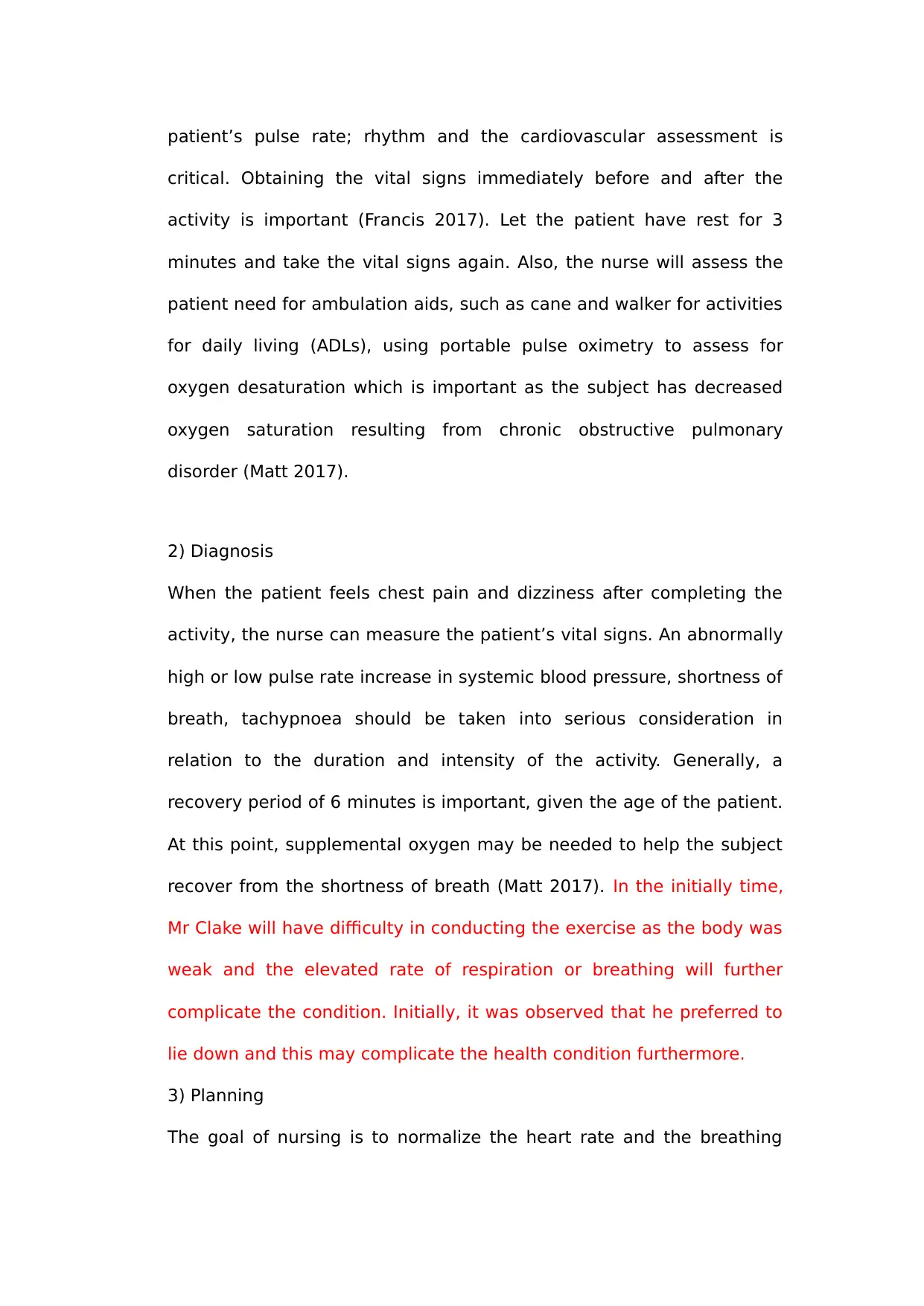
patient’s pulse rate; rhythm and the cardiovascular assessment is
critical. Obtaining the vital signs immediately before and after the
activity is important (Francis 2017). Let the patient have rest for 3
minutes and take the vital signs again. Also, the nurse will assess the
patient need for ambulation aids, such as cane and walker for activities
for daily living (ADLs), using portable pulse oximetry to assess for
oxygen desaturation which is important as the subject has decreased
oxygen saturation resulting from chronic obstructive pulmonary
disorder (Matt 2017).
2) Diagnosis
When the patient feels chest pain and dizziness after completing the
activity, the nurse can measure the patient’s vital signs. An abnormally
high or low pulse rate increase in systemic blood pressure, shortness of
breath, tachypnoea should be taken into serious consideration in
relation to the duration and intensity of the activity. Generally, a
recovery period of 6 minutes is important, given the age of the patient.
At this point, supplemental oxygen may be needed to help the subject
recover from the shortness of breath (Matt 2017). In the initially time,
Mr Clake will have difficulty in conducting the exercise as the body was
weak and the elevated rate of respiration or breathing will further
complicate the condition. Initially, it was observed that he preferred to
lie down and this may complicate the health condition furthermore.
3) Planning
The goal of nursing is to normalize the heart rate and the breathing
critical. Obtaining the vital signs immediately before and after the
activity is important (Francis 2017). Let the patient have rest for 3
minutes and take the vital signs again. Also, the nurse will assess the
patient need for ambulation aids, such as cane and walker for activities
for daily living (ADLs), using portable pulse oximetry to assess for
oxygen desaturation which is important as the subject has decreased
oxygen saturation resulting from chronic obstructive pulmonary
disorder (Matt 2017).
2) Diagnosis
When the patient feels chest pain and dizziness after completing the
activity, the nurse can measure the patient’s vital signs. An abnormally
high or low pulse rate increase in systemic blood pressure, shortness of
breath, tachypnoea should be taken into serious consideration in
relation to the duration and intensity of the activity. Generally, a
recovery period of 6 minutes is important, given the age of the patient.
At this point, supplemental oxygen may be needed to help the subject
recover from the shortness of breath (Matt 2017). In the initially time,
Mr Clake will have difficulty in conducting the exercise as the body was
weak and the elevated rate of respiration or breathing will further
complicate the condition. Initially, it was observed that he preferred to
lie down and this may complicate the health condition furthermore.
3) Planning
The goal of nursing is to normalize the heart rate and the breathing
Paraphrase This Document
Need a fresh take? Get an instant paraphrase of this document with our AI Paraphraser

issues of the patients. Breathing exercise and activities of daily life
training are important. In order to maintain the strength and mobility of
the musculoskeletal system, the lower intensity physical exercises plus
cardio can be planned. Teaching the subject, the self-care skills to
identify changes in physical characteristics are caused by intolerance,
is vital. Patients are able to verbally report daily whether they are able
to achieve the necessary daily activities (Matt, V., 2017). In addition,
the goal of activity intolerance is to increase the tolerance and
endurance of the activity. The engagement of the patient and family
member can be involved in the planning process. Individual session can
be conducted to obtain more information such as past history, daily
routines, likes and dislike from family and the present condition, pain
assessment and other information can be obtained from the patient. In
collaboration with all the stakeholders in the care process, the goals
can be formulated.
4) Implementation
The implementation of nursing goals of the first step is to improve the
breathing pattern of the subject and decrease anxiety. The nurse should
monitor the patients’ vital signs. Second, the patient has to practice
exhaling and inhaling daily, deep-breathing exercises three times a day.
This is in conjunction with the observation made during Day 0 for Mr
Clake, where the breathing rate was found to be higher than the normal
range. The patient needs to learn how to control breathing skills, use
pursed-lip breathing and diaphragmatic to help to breathe. Third, use
oxygen aid support and sitting up in a chair over 20 minutes in order to
training are important. In order to maintain the strength and mobility of
the musculoskeletal system, the lower intensity physical exercises plus
cardio can be planned. Teaching the subject, the self-care skills to
identify changes in physical characteristics are caused by intolerance,
is vital. Patients are able to verbally report daily whether they are able
to achieve the necessary daily activities (Matt, V., 2017). In addition,
the goal of activity intolerance is to increase the tolerance and
endurance of the activity. The engagement of the patient and family
member can be involved in the planning process. Individual session can
be conducted to obtain more information such as past history, daily
routines, likes and dislike from family and the present condition, pain
assessment and other information can be obtained from the patient. In
collaboration with all the stakeholders in the care process, the goals
can be formulated.
4) Implementation
The implementation of nursing goals of the first step is to improve the
breathing pattern of the subject and decrease anxiety. The nurse should
monitor the patients’ vital signs. Second, the patient has to practice
exhaling and inhaling daily, deep-breathing exercises three times a day.
This is in conjunction with the observation made during Day 0 for Mr
Clake, where the breathing rate was found to be higher than the normal
range. The patient needs to learn how to control breathing skills, use
pursed-lip breathing and diaphragmatic to help to breathe. Third, use
oxygen aid support and sitting up in a chair over 20 minutes in order to
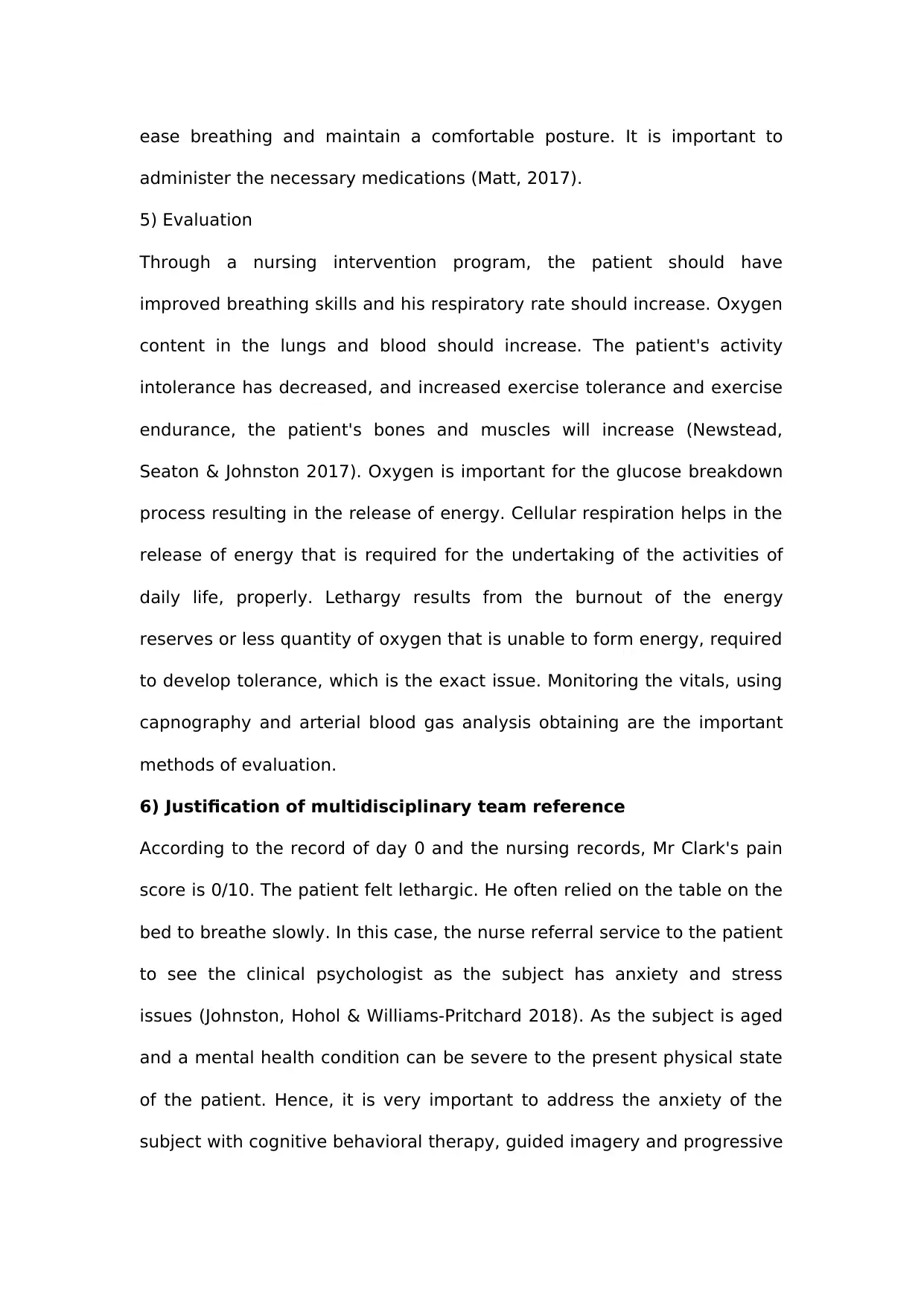
ease breathing and maintain a comfortable posture. It is important to
administer the necessary medications (Matt, 2017).
5) Evaluation
Through a nursing intervention program, the patient should have
improved breathing skills and his respiratory rate should increase. Oxygen
content in the lungs and blood should increase. The patient's activity
intolerance has decreased, and increased exercise tolerance and exercise
endurance, the patient's bones and muscles will increase (Newstead,
Seaton & Johnston 2017). Oxygen is important for the glucose breakdown
process resulting in the release of energy. Cellular respiration helps in the
release of energy that is required for the undertaking of the activities of
daily life, properly. Lethargy results from the burnout of the energy
reserves or less quantity of oxygen that is unable to form energy, required
to develop tolerance, which is the exact issue. Monitoring the vitals, using
capnography and arterial blood gas analysis obtaining are the important
methods of evaluation.
6) Justification of multidisciplinary team reference
According to the record of day 0 and the nursing records, Mr Clark's pain
score is 0/10. The patient felt lethargic. He often relied on the table on the
bed to breathe slowly. In this case, the nurse referral service to the patient
to see the clinical psychologist as the subject has anxiety and stress
issues (Johnston, Hohol & Williams-Pritchard 2018). As the subject is aged
and a mental health condition can be severe to the present physical state
of the patient. Hence, it is very important to address the anxiety of the
subject with cognitive behavioral therapy, guided imagery and progressive
administer the necessary medications (Matt, 2017).
5) Evaluation
Through a nursing intervention program, the patient should have
improved breathing skills and his respiratory rate should increase. Oxygen
content in the lungs and blood should increase. The patient's activity
intolerance has decreased, and increased exercise tolerance and exercise
endurance, the patient's bones and muscles will increase (Newstead,
Seaton & Johnston 2017). Oxygen is important for the glucose breakdown
process resulting in the release of energy. Cellular respiration helps in the
release of energy that is required for the undertaking of the activities of
daily life, properly. Lethargy results from the burnout of the energy
reserves or less quantity of oxygen that is unable to form energy, required
to develop tolerance, which is the exact issue. Monitoring the vitals, using
capnography and arterial blood gas analysis obtaining are the important
methods of evaluation.
6) Justification of multidisciplinary team reference
According to the record of day 0 and the nursing records, Mr Clark's pain
score is 0/10. The patient felt lethargic. He often relied on the table on the
bed to breathe slowly. In this case, the nurse referral service to the patient
to see the clinical psychologist as the subject has anxiety and stress
issues (Johnston, Hohol & Williams-Pritchard 2018). As the subject is aged
and a mental health condition can be severe to the present physical state
of the patient. Hence, it is very important to address the anxiety of the
subject with cognitive behavioral therapy, guided imagery and progressive
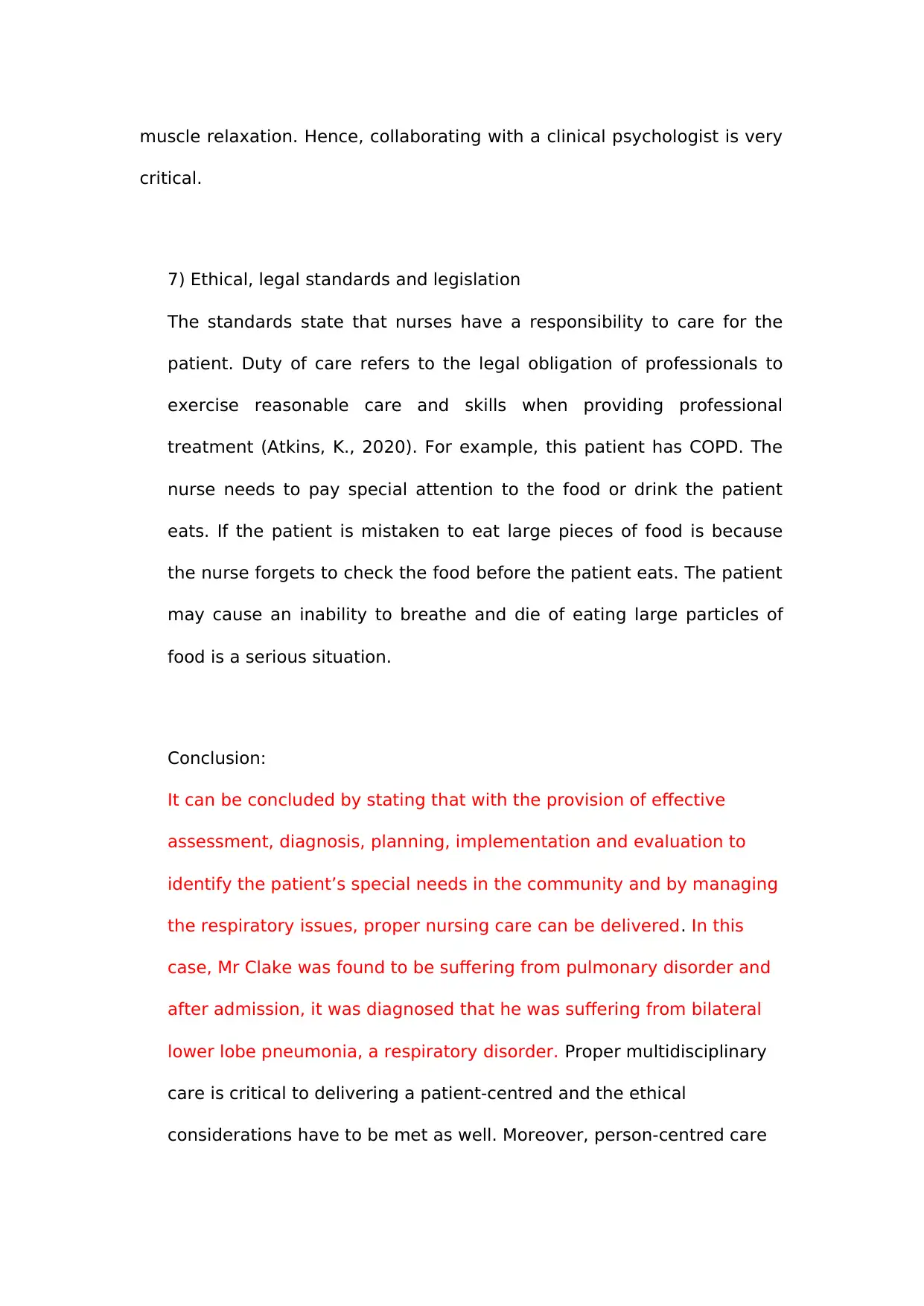
muscle relaxation. Hence, collaborating with a clinical psychologist is very
critical.
7) Ethical, legal standards and legislation
The standards state that nurses have a responsibility to care for the
patient. Duty of care refers to the legal obligation of professionals to
exercise reasonable care and skills when providing professional
treatment (Atkins, K., 2020). For example, this patient has COPD. The
nurse needs to pay special attention to the food or drink the patient
eats. If the patient is mistaken to eat large pieces of food is because
the nurse forgets to check the food before the patient eats. The patient
may cause an inability to breathe and die of eating large particles of
food is a serious situation.
Conclusion:
It can be concluded by stating that with the provision of effective
assessment, diagnosis, planning, implementation and evaluation to
identify the patient’s special needs in the community and by managing
the respiratory issues, proper nursing care can be delivered. In this
case, Mr Clake was found to be suffering from pulmonary disorder and
after admission, it was diagnosed that he was suffering from bilateral
lower lobe pneumonia, a respiratory disorder. Proper multidisciplinary
care is critical to delivering a patient-centred and the ethical
considerations have to be met as well. Moreover, person-centred care
critical.
7) Ethical, legal standards and legislation
The standards state that nurses have a responsibility to care for the
patient. Duty of care refers to the legal obligation of professionals to
exercise reasonable care and skills when providing professional
treatment (Atkins, K., 2020). For example, this patient has COPD. The
nurse needs to pay special attention to the food or drink the patient
eats. If the patient is mistaken to eat large pieces of food is because
the nurse forgets to check the food before the patient eats. The patient
may cause an inability to breathe and die of eating large particles of
food is a serious situation.
Conclusion:
It can be concluded by stating that with the provision of effective
assessment, diagnosis, planning, implementation and evaluation to
identify the patient’s special needs in the community and by managing
the respiratory issues, proper nursing care can be delivered. In this
case, Mr Clake was found to be suffering from pulmonary disorder and
after admission, it was diagnosed that he was suffering from bilateral
lower lobe pneumonia, a respiratory disorder. Proper multidisciplinary
care is critical to delivering a patient-centred and the ethical
considerations have to be met as well. Moreover, person-centred care
Secure Best Marks with AI Grader
Need help grading? Try our AI Grader for instant feedback on your assignments.
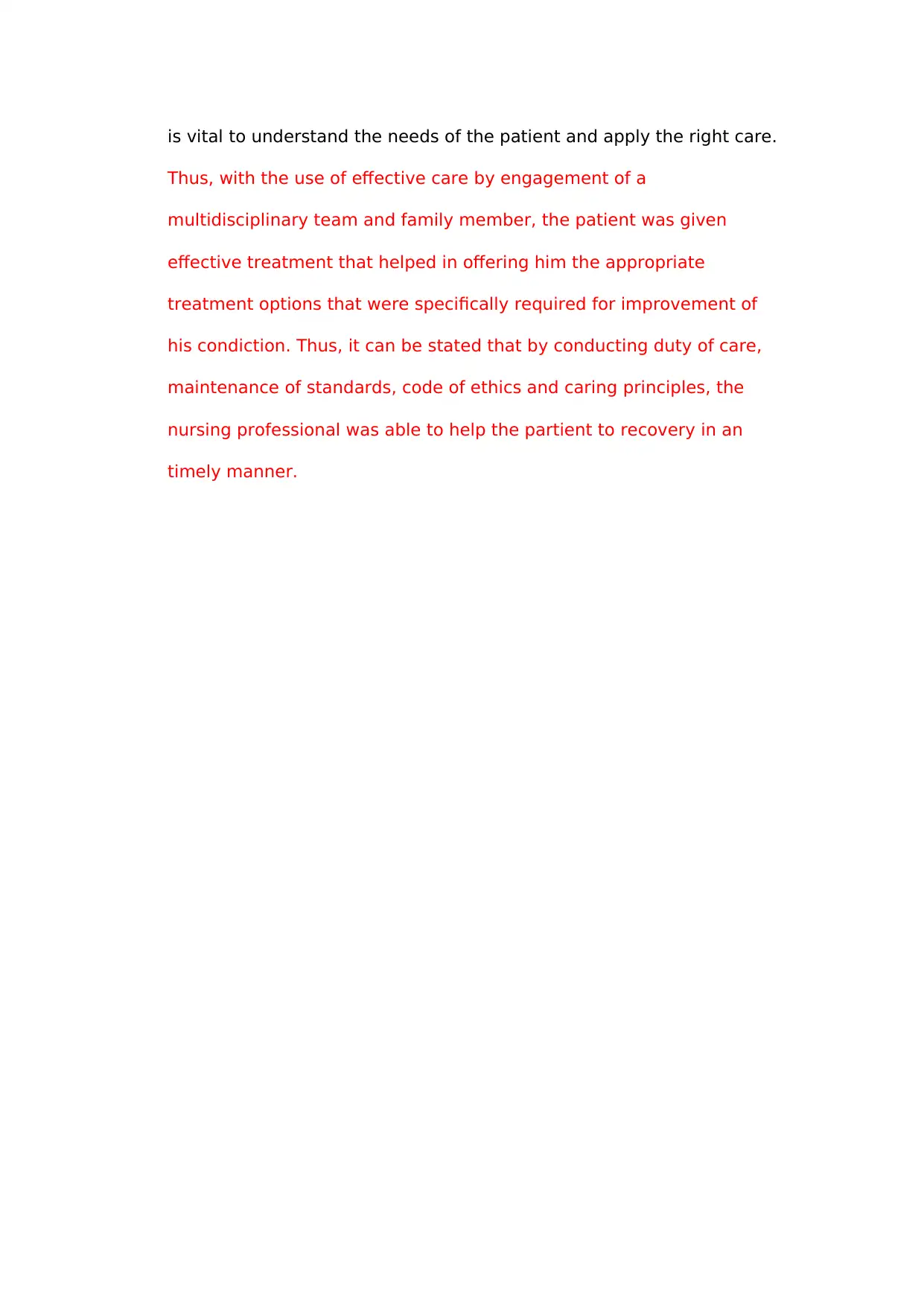
is vital to understand the needs of the patient and apply the right care.
Thus, with the use of effective care by engagement of a
multidisciplinary team and family member, the patient was given
effective treatment that helped in offering him the appropriate
treatment options that were specifically required for improvement of
his condiction. Thus, it can be stated that by conducting duty of care,
maintenance of standards, code of ethics and caring principles, the
nursing professional was able to help the partient to recovery in an
timely manner.
Thus, with the use of effective care by engagement of a
multidisciplinary team and family member, the patient was given
effective treatment that helped in offering him the appropriate
treatment options that were specifically required for improvement of
his condiction. Thus, it can be stated that by conducting duty of care,
maintenance of standards, code of ethics and caring principles, the
nursing professional was able to help the partient to recovery in an
timely manner.
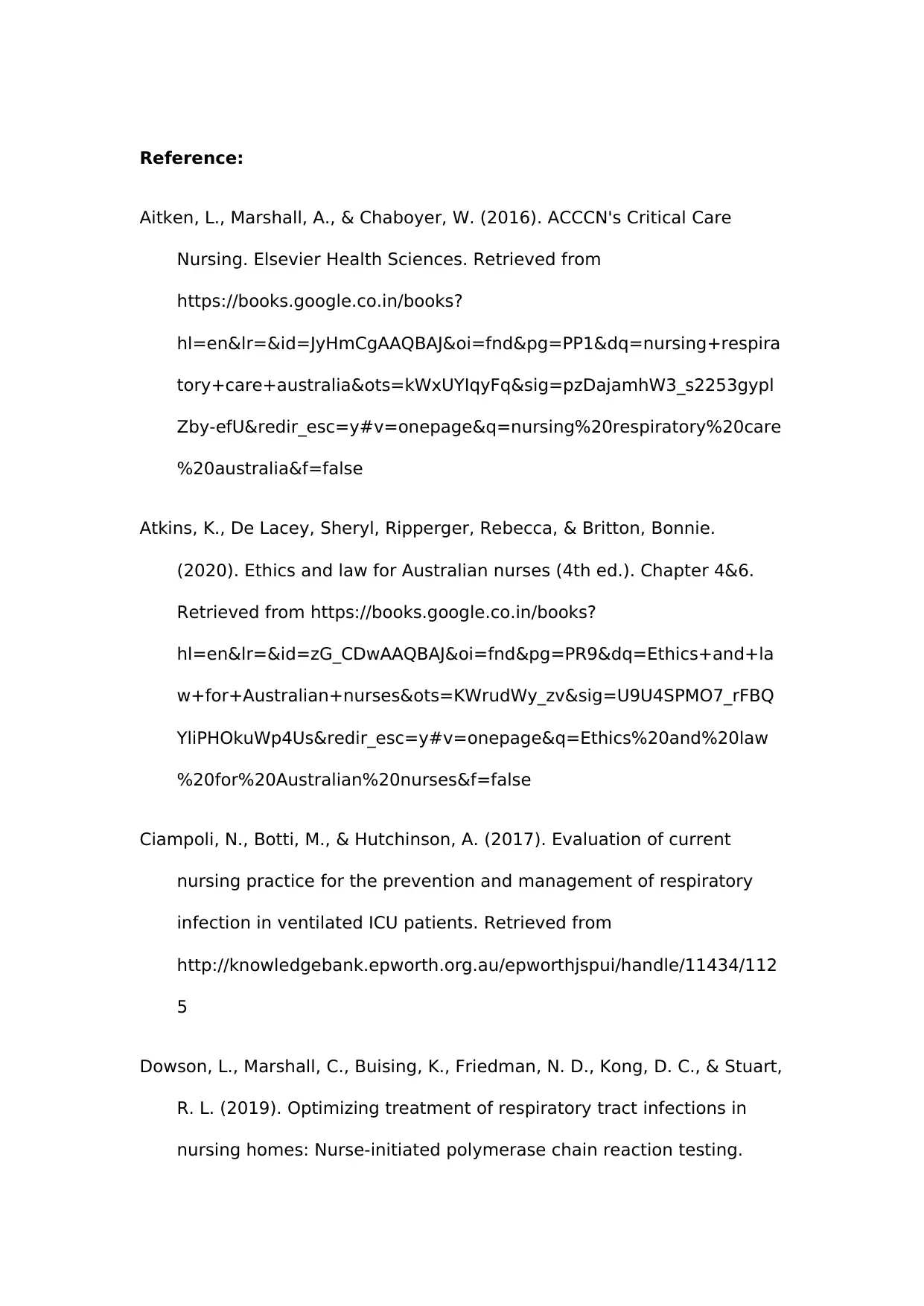
Reference:
Aitken, L., Marshall, A., & Chaboyer, W. (2016). ACCCN's Critical Care
Nursing. Elsevier Health Sciences. Retrieved from
https://books.google.co.in/books?
hl=en&lr=&id=JyHmCgAAQBAJ&oi=fnd&pg=PP1&dq=nursing+respira
tory+care+australia&ots=kWxUYIqyFq&sig=pzDajamhW3_s2253gypl
Zby-efU&redir_esc=y#v=onepage&q=nursing%20respiratory%20care
%20australia&f=false
Atkins, K., De Lacey, Sheryl, Ripperger, Rebecca, & Britton, Bonnie.
(2020). Ethics and law for Australian nurses (4th ed.). Chapter 4&6.
Retrieved from https://books.google.co.in/books?
hl=en&lr=&id=zG_CDwAAQBAJ&oi=fnd&pg=PR9&dq=Ethics+and+la
w+for+Australian+nurses&ots=KWrudWy_zv&sig=U9U4SPMO7_rFBQ
YliPHOkuWp4Us&redir_esc=y#v=onepage&q=Ethics%20and%20law
%20for%20Australian%20nurses&f=false
Ciampoli, N., Botti, M., & Hutchinson, A. (2017). Evaluation of current
nursing practice for the prevention and management of respiratory
infection in ventilated ICU patients. Retrieved from
http://knowledgebank.epworth.org.au/epworthjspui/handle/11434/112
5
Dowson, L., Marshall, C., Buising, K., Friedman, N. D., Kong, D. C., & Stuart,
R. L. (2019). Optimizing treatment of respiratory tract infections in
nursing homes: Nurse-initiated polymerase chain reaction testing.
Aitken, L., Marshall, A., & Chaboyer, W. (2016). ACCCN's Critical Care
Nursing. Elsevier Health Sciences. Retrieved from
https://books.google.co.in/books?
hl=en&lr=&id=JyHmCgAAQBAJ&oi=fnd&pg=PP1&dq=nursing+respira
tory+care+australia&ots=kWxUYIqyFq&sig=pzDajamhW3_s2253gypl
Zby-efU&redir_esc=y#v=onepage&q=nursing%20respiratory%20care
%20australia&f=false
Atkins, K., De Lacey, Sheryl, Ripperger, Rebecca, & Britton, Bonnie.
(2020). Ethics and law for Australian nurses (4th ed.). Chapter 4&6.
Retrieved from https://books.google.co.in/books?
hl=en&lr=&id=zG_CDwAAQBAJ&oi=fnd&pg=PR9&dq=Ethics+and+la
w+for+Australian+nurses&ots=KWrudWy_zv&sig=U9U4SPMO7_rFBQ
YliPHOkuWp4Us&redir_esc=y#v=onepage&q=Ethics%20and%20law
%20for%20Australian%20nurses&f=false
Ciampoli, N., Botti, M., & Hutchinson, A. (2017). Evaluation of current
nursing practice for the prevention and management of respiratory
infection in ventilated ICU patients. Retrieved from
http://knowledgebank.epworth.org.au/epworthjspui/handle/11434/112
5
Dowson, L., Marshall, C., Buising, K., Friedman, N. D., Kong, D. C., & Stuart,
R. L. (2019). Optimizing treatment of respiratory tract infections in
nursing homes: Nurse-initiated polymerase chain reaction testing.
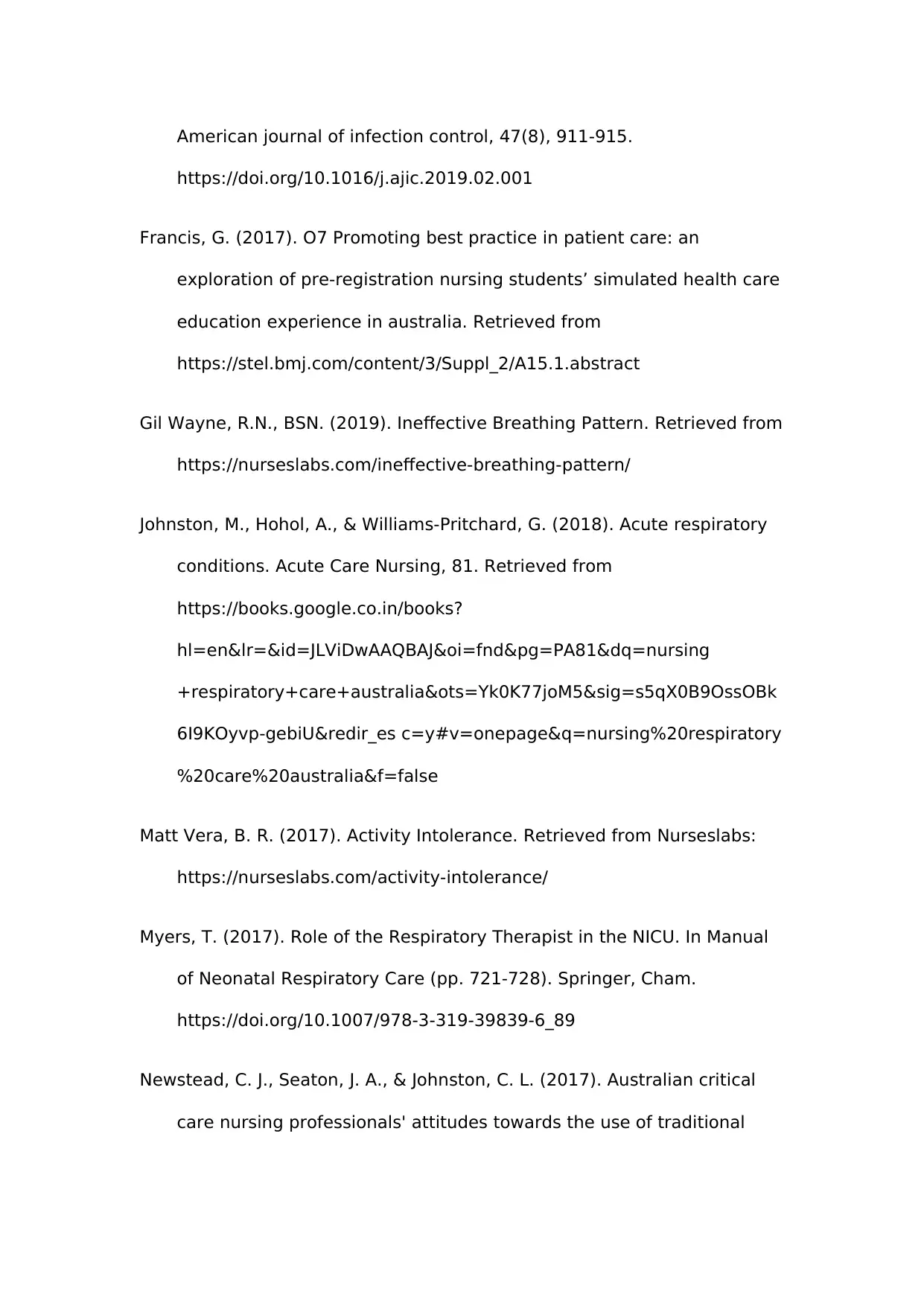
American journal of infection control, 47(8), 911-915.
https://doi.org/10.1016/j.ajic.2019.02.001
Francis, G. (2017). O7 Promoting best practice in patient care: an
exploration of pre-registration nursing students’ simulated health care
education experience in australia. Retrieved from
https://stel.bmj.com/content/3/Suppl_2/A15.1.abstract
Gil Wayne, R.N., BSN. (2019). Ineffective Breathing Pattern. Retrieved from
https://nurseslabs.com/ineffective-breathing-pattern/
Johnston, M., Hohol, A., & Williams-Pritchard, G. (2018). Acute respiratory
conditions. Acute Care Nursing, 81. Retrieved from
https://books.google.co.in/books?
hl=en&lr=&id=JLViDwAAQBAJ&oi=fnd&pg=PA81&dq=nursing
+respiratory+care+australia&ots=Yk0K77joM5&sig=s5qX0B9OssOBk
6I9KOyvp-gebiU&redir_es c=y#v=onepage&q=nursing%20respiratory
%20care%20australia&f=false
Matt Vera, B. R. (2017). Activity Intolerance. Retrieved from Nurseslabs:
https://nurseslabs.com/activity-intolerance/
Myers, T. (2017). Role of the Respiratory Therapist in the NICU. In Manual
of Neonatal Respiratory Care (pp. 721-728). Springer, Cham.
https://doi.org/10.1007/978-3-319-39839-6_89
Newstead, C. J., Seaton, J. A., & Johnston, C. L. (2017). Australian critical
care nursing professionals' attitudes towards the use of traditional
https://doi.org/10.1016/j.ajic.2019.02.001
Francis, G. (2017). O7 Promoting best practice in patient care: an
exploration of pre-registration nursing students’ simulated health care
education experience in australia. Retrieved from
https://stel.bmj.com/content/3/Suppl_2/A15.1.abstract
Gil Wayne, R.N., BSN. (2019). Ineffective Breathing Pattern. Retrieved from
https://nurseslabs.com/ineffective-breathing-pattern/
Johnston, M., Hohol, A., & Williams-Pritchard, G. (2018). Acute respiratory
conditions. Acute Care Nursing, 81. Retrieved from
https://books.google.co.in/books?
hl=en&lr=&id=JLViDwAAQBAJ&oi=fnd&pg=PA81&dq=nursing
+respiratory+care+australia&ots=Yk0K77joM5&sig=s5qX0B9OssOBk
6I9KOyvp-gebiU&redir_es c=y#v=onepage&q=nursing%20respiratory
%20care%20australia&f=false
Matt Vera, B. R. (2017). Activity Intolerance. Retrieved from Nurseslabs:
https://nurseslabs.com/activity-intolerance/
Myers, T. (2017). Role of the Respiratory Therapist in the NICU. In Manual
of Neonatal Respiratory Care (pp. 721-728). Springer, Cham.
https://doi.org/10.1007/978-3-319-39839-6_89
Newstead, C. J., Seaton, J. A., & Johnston, C. L. (2017). Australian critical
care nursing professionals' attitudes towards the use of traditional
Paraphrase This Document
Need a fresh take? Get an instant paraphrase of this document with our AI Paraphraser
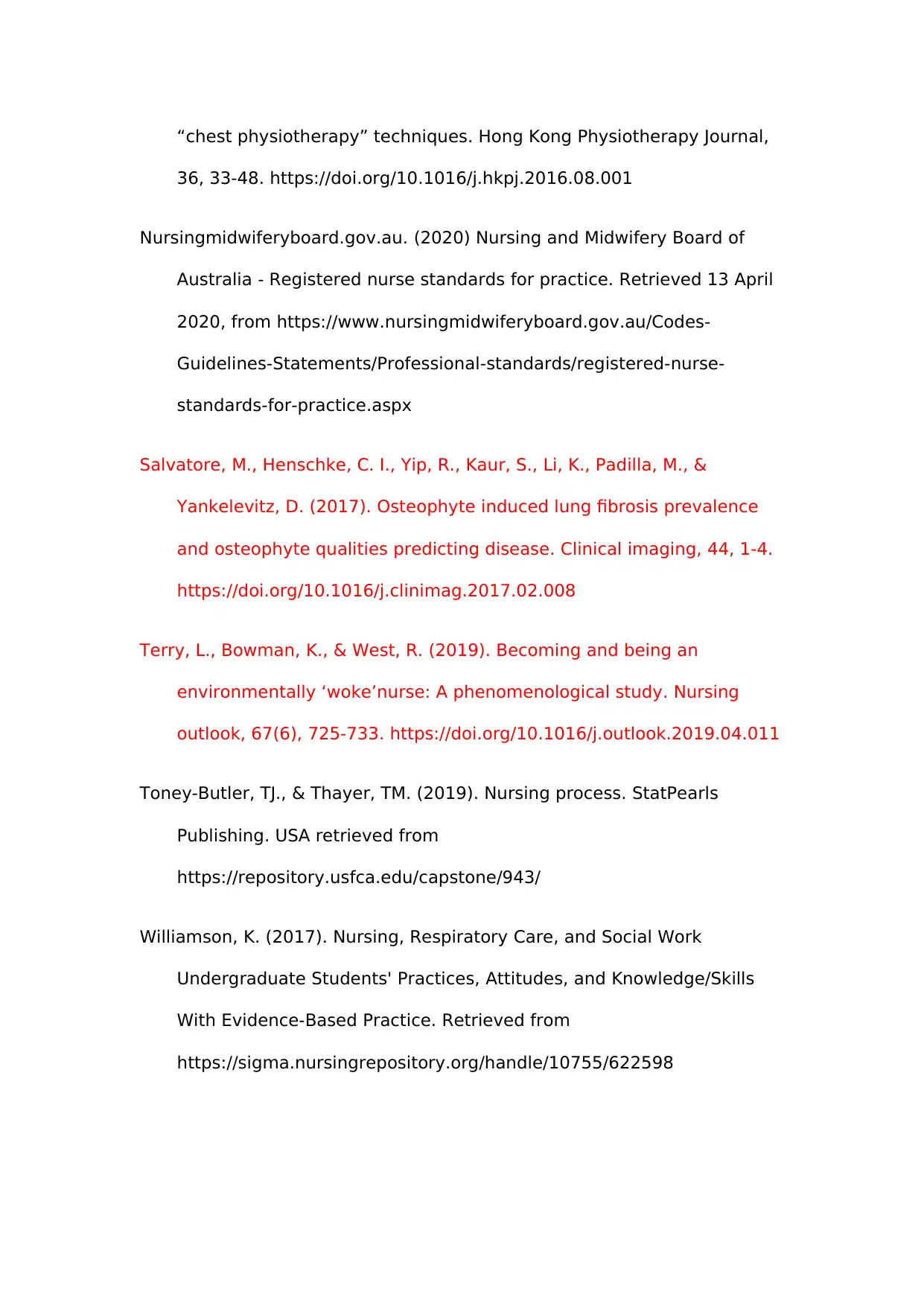
“chest physiotherapy” techniques. Hong Kong Physiotherapy Journal,
36, 33-48. https://doi.org/10.1016/j.hkpj.2016.08.001
Nursingmidwiferyboard.gov.au. (2020) Nursing and Midwifery Board of
Australia - Registered nurse standards for practice. Retrieved 13 April
2020, from https://www.nursingmidwiferyboard.gov.au/Codes-
Guidelines-Statements/Professional-standards/registered-nurse-
standards-for-practice.aspx
Salvatore, M., Henschke, C. I., Yip, R., Kaur, S., Li, K., Padilla, M., &
Yankelevitz, D. (2017). Osteophyte induced lung fibrosis prevalence
and osteophyte qualities predicting disease. Clinical imaging, 44, 1-4.
https://doi.org/10.1016/j.clinimag.2017.02.008
Terry, L., Bowman, K., & West, R. (2019). Becoming and being an
environmentally ‘woke’nurse: A phenomenological study. Nursing
outlook, 67(6), 725-733. https://doi.org/10.1016/j.outlook.2019.04.011
Toney-Butler, TJ., & Thayer, TM. (2019). Nursing process. StatPearls
Publishing. USA retrieved from
https://repository.usfca.edu/capstone/943/
Williamson, K. (2017). Nursing, Respiratory Care, and Social Work
Undergraduate Students' Practices, Attitudes, and Knowledge/Skills
With Evidence-Based Practice. Retrieved from
https://sigma.nursingrepository.org/handle/10755/622598
36, 33-48. https://doi.org/10.1016/j.hkpj.2016.08.001
Nursingmidwiferyboard.gov.au. (2020) Nursing and Midwifery Board of
Australia - Registered nurse standards for practice. Retrieved 13 April
2020, from https://www.nursingmidwiferyboard.gov.au/Codes-
Guidelines-Statements/Professional-standards/registered-nurse-
standards-for-practice.aspx
Salvatore, M., Henschke, C. I., Yip, R., Kaur, S., Li, K., Padilla, M., &
Yankelevitz, D. (2017). Osteophyte induced lung fibrosis prevalence
and osteophyte qualities predicting disease. Clinical imaging, 44, 1-4.
https://doi.org/10.1016/j.clinimag.2017.02.008
Terry, L., Bowman, K., & West, R. (2019). Becoming and being an
environmentally ‘woke’nurse: A phenomenological study. Nursing
outlook, 67(6), 725-733. https://doi.org/10.1016/j.outlook.2019.04.011
Toney-Butler, TJ., & Thayer, TM. (2019). Nursing process. StatPearls
Publishing. USA retrieved from
https://repository.usfca.edu/capstone/943/
Williamson, K. (2017). Nursing, Respiratory Care, and Social Work
Undergraduate Students' Practices, Attitudes, and Knowledge/Skills
With Evidence-Based Practice. Retrieved from
https://sigma.nursingrepository.org/handle/10755/622598
1 out of 14
Related Documents
Your All-in-One AI-Powered Toolkit for Academic Success.
+13062052269
info@desklib.com
Available 24*7 on WhatsApp / Email
![[object Object]](/_next/static/media/star-bottom.7253800d.svg)
Unlock your academic potential
© 2024 | Zucol Services PVT LTD | All rights reserved.




